Looking Glass
With the UAE-IX looking glass service, it is possible to easily search for an AS number, a peer or a particular IP prefix or prefixes with particular BGP communities. In addition, the looking glass service provides information on why a certain route is rejected by the route server (e.g. due to IRR filters). Below you can find a detailed explanation of how to use the looking glass, how to narrow down search results, what exactly you can see, some typical search examples, and more information about query strings and how to use the API in your own scripts.
The UAE-IX Looking Glass utilizes the open source projects Alice-LG and birdwatcher. A big thank you to all who contributed to these projects!
How to use the UAE-IX Looking Glass
There are two basic ways to get information:
- The global search over all route servers (1)
- The neighbor overview (2)
With the global search, you can search for IP prefixes, peer names, ASNs and BGP communities. This is the fastest way if you need to get information about a specific network.
With the neighbor overview, you can have a look at a specific route server. It shows you which networks are available at a specific route server, provides BGP session information (state, last state changed), and gives you a summary of received/accepted/filtered routes from each peer.
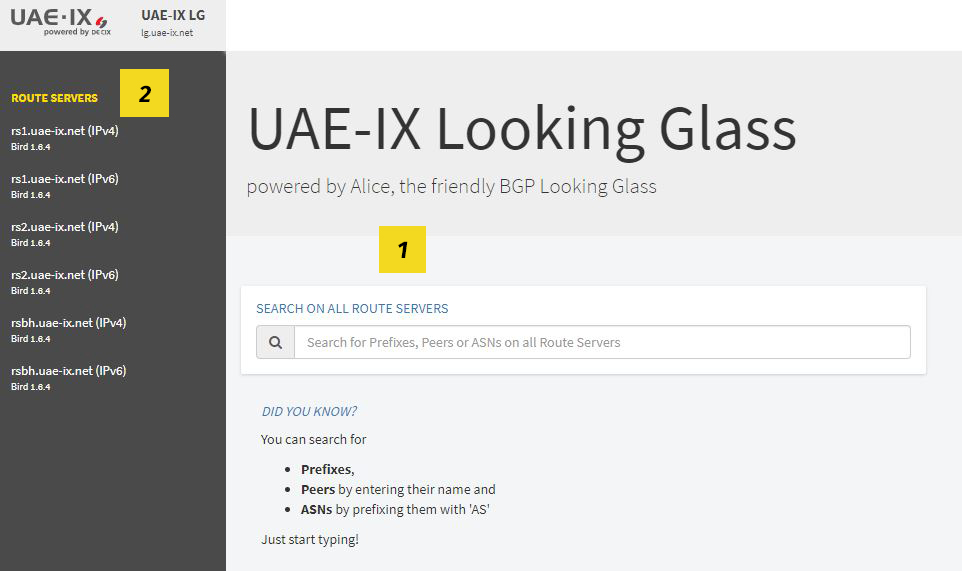
The global search over all route servers
With the global search, you can search across all UAE-IX route servers. You can directly search for:
- Prefixes
- Peers (by name, e.g. Packet Clearing House)
- ASNs (by prefixing them with 'AS', e.g. AS42)
- BGP communities (by prefixing them with '#', e.g. #65535:666)
Just type in what you're looking for.
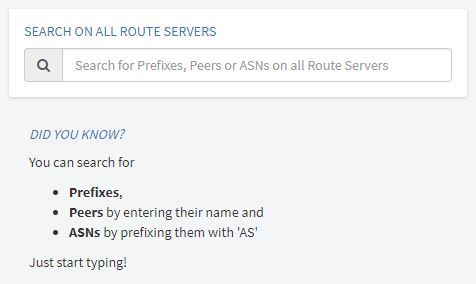
The global search funktion
Narrow down the search results
On the results page, it is possible to narrow down the search results with three drop-down menus on the right. You can refine your search by:
- Route server
- Neighbor (in case your search matches more than one route server peer)
- BGP communities (multiple BGP community values can be selected; the communities are ordered by value)
The selected filters appear above the drop-down field and can be removed easily by clicking the red 'X' icon.
Please note: The database that is used to generate the search results in the global search contains data that may be up to 30 minutes old. The actual cache age is displayed in the upper right corner.
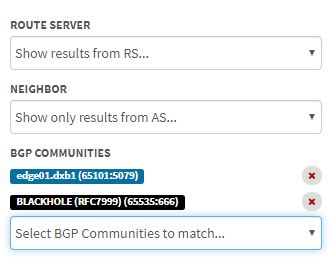
Narrow down results of the global search
The neighbor overview
Using the neighbor overview, you can have a look at individual UAE-IX route servers and their BGP peers (and their current status, e.g. session up, down, or errors).
To start the overview, select a UAE-IX route server. This will result in a view that contains all peers that are known to the selected route server. All table columns are sortable in ascending or descending order.
Narrow down the displayed data
With the search bar at the top, you can narrow down the data displayed. You can search for:
- Neighbor IP
- Peers (e.g. Packet Clearing House)
- ASNs (e.g. AS42)
Get information about specific route server neigbor
You can see more information about a specific route server neighbor by clicking on its neighbor IP. All routes (filtered, accepted, and not exported) are shown. If the selected peer operates more than one router, you can switch between routers by clicking the tabs shown at the top. There are also quick links available to jump to sections with filtered, accepted and not exported routes directly. Routes that are the best path are marked with a star icon.
If a route is rejected, the reason is displayed in text below the affected route. You can hover over the text to get a detailed explanation of what went wrong and how to fix it. You can also click on the reject reason to explore the route in question in IRR Explorer.
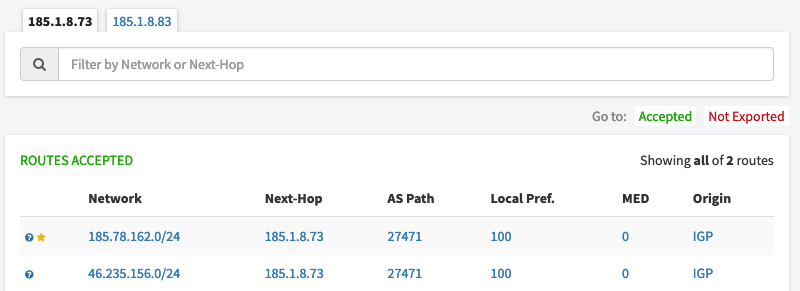
Information on a specific route server neighbor
To get more detailed information about a route, just click on it. This will show you the BGP attributes:
- Age of the route (when it has been learned)
- Origin of the route (IGP/EGP/unknown)
- Local Preference
- BGP next-hop
- MED
- AS Path
- BGP Standard, Extended and Large communities in human readable format if known by the route server (i.e. UAE-IX Operational and Informational Communities and well-known BGP Communities)
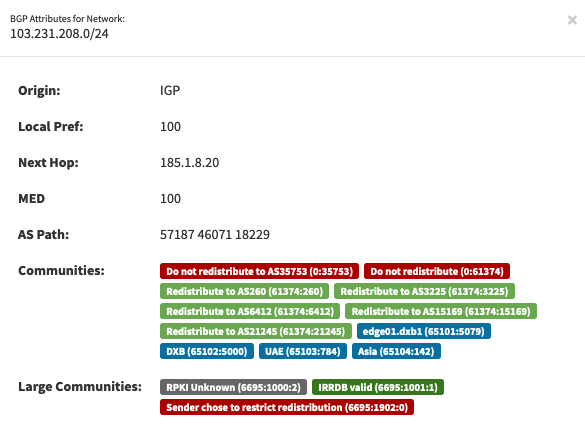
Detailed route information with BGP attributes
Typical search examples
Find out which prefixes are filtered on your session(s)
- Enter your ASN in the global search field on the start page
- A list of prefixes from your ASN on all route servers is shown
- Filtered prefixes are shown at the top of the page (before accepted routes)
- You can narrow down your search by using the dropdown menus on the right
- You can click on the link in the description column to go the corresponding route server for the selected prefix
Using query strings
It is possible to use query strings in URLs, e.g. in bookmarks:
- Search for a prefix (e.g. 8.8.8.0/24) in the global search (lookup on all route servers): https://lg.uae-ix.net/search?q=8.8.8.0/24
- Search for AS15169 (Google) on route server rs1_dxb_ipv4*: https://lg.ue-ix.net/routeservers/rs1_dxb_ipv4?s=asn&o=asc&q=15169
- Search for Google on route server rs1_dxb_ipv4*: https://lg.uae-ix.net/routeservers/rs1_dxb_ipv4?s=asn&o=asc&q=Google
* Just replace rs1_dxb1_ipv4 with the corresponding RS
Use the API in your own scripts
Alice provides a JSON API for all UAE-IX route servers. You can use the API in your own scripts. The following endpoints are available:
| Endpoint/example query | Description |
| /api/v1/status | Query the status of Alice |
| /api/v1/routeservers/rs1_dxb_ipv4/status | Query the status of route server rs1_dxb_ipv4 |
| /api/v1/routeservers/rs1_dxb_ipv4/neighbors/R8_28/routes/received | for a list of received routes from peer R8_28 (185.1.8.28) |
| /api/v1/routeservers/rs1_dxb_ipv4/neighbors/R8_28/routes/not-exported | Query route server rs1_dxb_ipv4 for a list of routes not exported to peer R8_28 (185.1.8.28) |
| /api/v1/routeservers/rs1_dxb_ipv4/neighbors/R8_28/routes/filtered | Query route server rs1_dxb_ipv4 for a list of filtered routes from peer R8_28 (185.1.8.28) |
| /api/v1/routeservers/rs1_dxb_ipv4/neighbors | Query route server rs1_dxb_ipv4 for a list of its neighbors |
| /api/v1/routeservers | Query a list of route servers known to Alice |
| /api/v1/lookup/prefix?q=8.8.8.0/24 | Query Alice for prefix 8.8.8.0/24 |
| /api/v1/config | Query the Alice configuration |
Questions?
If you have any questions, please feel free to contact us!
